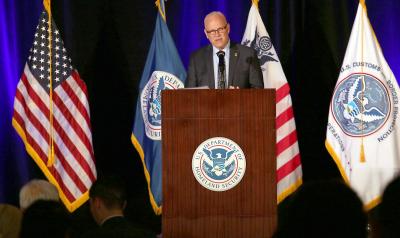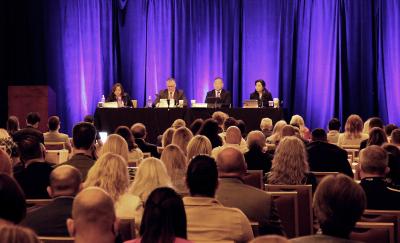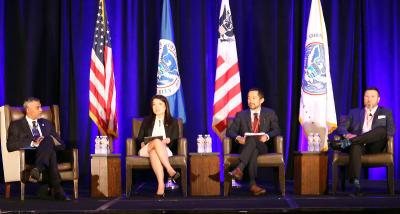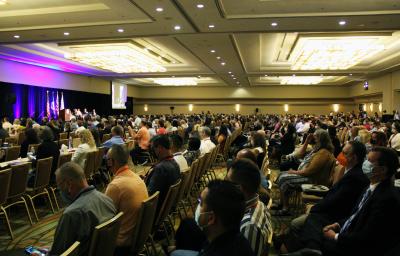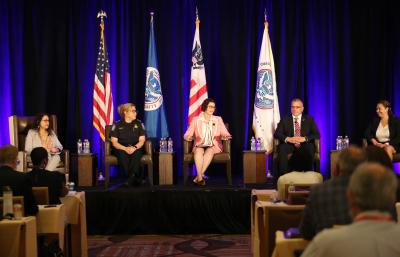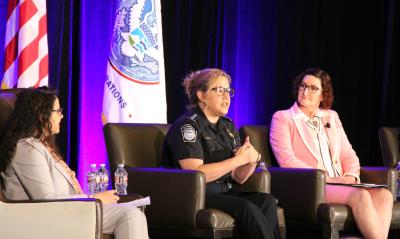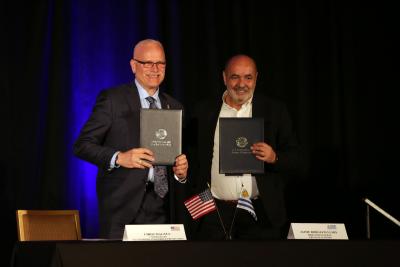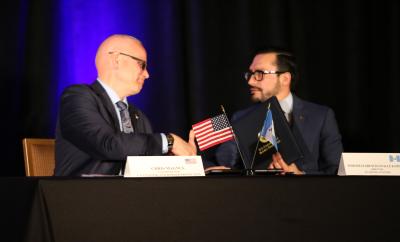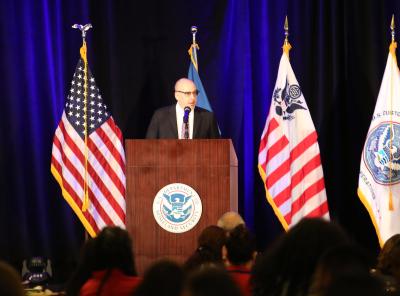The focus was on the future at U.S. Customs and Border Protection’s first Trade Facilitation and Cargo Security Summit. Over 3,000 attendees, 1,000 on-site and more than 2,000 virtually, gathered in Anaheim, California, July 18-20, to learn more about CBP’s forward vision in a constantly changing trade environment. It was the first time CBP had hosted an in-person trade event of this magnitude since the pandemic began two-and-a-half years ago. It was also the first time the agency had combined two of its signature events—CBP’s annual trade symposium and the Customs Trade Partnership Against Terrorism conference, or CTPAT.
“I know we have experienced some incredible challenges over the past few years. In fact, even saying, ‘incredible challenges,’ sounds like a gross understatement. Some of these challenges have been driven by the pandemic. Others are a result of global, political, economic, and environmental trends. But they’ve been difficult,” said CBP Commissioner Chris Magnus, who welcomed the hybrid audience from the Hilton Anaheim.
“CBP has not been immune to these challenges,” he continued. “But I think the men and women of our agency have stood firm in their commitment to fulfill our mission.” Magnus noted that the agency receives a lot of media attention about immigration. “I think sometimes what gets lost in the coverage is the incredible humanitarian work our people do,” said Magnus, adding that the humanitarian focus of the agency extends to the trade mission.
“CBP’s trade experts are leading the global fight against forced labor, a practice with more than 25 million victims worldwide. We know forced labor hurts vulnerable workers of all kinds, legitimate businesses and consumers. I am incredibly proud of the work CBP has done to address this issue,” said Magnus. “Over the past year, CBP has issued five new withhold release orders and two findings. So far in this fiscal year 2022, CBP has detained approximately 2,000 shipments worth an estimated $358 million.”
Magnus explained that the significant increase in detentions over the last year was largely due to improvements in how CBP’s trade staff targets shipments. “We’re also constantly evaluating our enforcement posture. Last fiscal year, CBP modified four withhold release orders after the target entities demonstrated that they had fully corrected forced labor conditions,” said Magnus. “This year, CBP has engaged with a record number of foreign entities that are remediating forced labor conditions in their production, which will help improve working and living conditions for thousands and thousands of workers. This is exactly the kind of change we want to see.”
Magnus also spoke about the implementation of the Uyghur Forced Labor Prevention Act, a law that many in the trade community thought would create problems for the flow of legitimate cargo. “I’m sure you heard or read it was going to be the end of everything when it came to the free flow of goods, but instead, CBP has worked hard to prepare for the June 21st deadline,” said Magnus. “When this went into effect, we published guidance for industry, we held regular calls and meetings with trade partners, we kept Congress up to date with our progress,” said Magnus. “Because of the team’s focus on implementation and partnership with many of you, we’re minimizing disruptions to legitimate cargo while showing the world that forced labor has no place in U.S. supply chains.”
Green Trade Strategy
CBP’s Green Trade Strategy was among the many other agency initiatives the commissioner discussed. The strategy, an agency-wide strategic plan, is aimed at lowering carbon emissions and addressing the impacts of climate change as it relates to trade. “I’d like to highlight this as a key priority of mine and CBP,” said Magnus. “Just a few weeks ago, I had the chance to participate in the World Customs Organization meeting in Brussels, and we talked a lot about this strategy with our international counterparts.” Magnus explained that the WCO is an independent body that represents 184 customs administrations across the globe, which collectively process about 98% of world trade. “So, gaining support for the Green Trade Strategy among the nations in this body is really very important,” he said.
Magnus appealed to the trade community for help. “Look, we’re at a crossroads when it comes to looking at trade through the lens of climate change and environmental protection. Here’s how I think about it. Our children are counting on our country and our many businesses and companies to take the lead in promoting green trade globally,” said Magnus. “I look forward to collaborating with all of you to promote these efforts. We have to do it if we’re going to combat climate change and drive global progress in this area.”
The commissioner also shared that he announced CBP’s intent to nominate Ian Saunders as the U.S. candidate for WCO Secretary General while he was at the WCO meeting in Brussels. “This is important because CBP is an integral member of the WCO and we believe Ian will sustain a pragmatic approach to leading this global body,” said Magnus. “He is committed to respecting the WCO’s rich past while innovating to address supply chain disruptions, climate change and other challenges.”
Magnus also gave glowing praise to CTPAT. “This program continues to be one of our most valuable partnerships that we have with industry. And by taking the steps to become CTPAT members, you’re not only bolstering our security capabilities, but you also help us to take a risk-based approach to facilitate cargo into the country,” said Magnus, noting that the program’s current compliance rate of 99% is the highest level it has ever been. “Since March 2020, the program has processed over 1,500 new applicants with 250 currently in the queue,” he said.
Deputy Secretary John Tien of the Department of Homeland Security also welcomed attendees in an opening video. He, too, spoke about the importance of partnership. “Our partnerships reflect what we know to be true: that safe and secure trade and supply chains are as vital as they are complex; as crucial as they are interconnected; as essential as they are dynamic, challenging and ever-changing,” said Tien.
21st Century Vision
The first day of the summit opened with a number of breakout sessions. One of the panel discussions focused on the 21st Century Customs Framework, a CBP initiative that addresses current and future trade challenges and modernization barriers. “1993 is when we last experienced a major, comprehensive overhaul of our customs authorities. That was 29 years ago,” said Garrett Wright, CBP’s director of trade modernization, who moderated the panel. “Twenty-nine years ago, trade was largely containerized whereas today we’re processing one billion small packages a year. Twenty-nine years ago, Canada was our No. 1 importer into the United States. Today, it’s China. We’re seeing a lot of risk coming from that part of the world. The landscape in which we operate has changed drastically.”
Panelist Brian White, the industry lead on the 21st Century Task Force, gave an industry perspective. “As trade members, we face unprecedented challenges in moving cargo seamlessly, whether it’s due to port congestion or other supply chain constraints globally,” said White, the senior director of global customs and trade facilitation for Intel Corporation’s International Trade Group. “We believe the cornerstone of the 21st Century Customs Framework should be to seek methods to digitize and reduce the complexity of compiling and exchanging data with government agencies. Collectively, as the trade community, we need to partner with CBP and Congress to harmonize the trade data regulations so that they represent our commercial processes.”
Another panelist from a partner government agency, Dan Solis, the U.S. Food and Drug Administration’s assistant commissioner for the Office of Enforcement and Import Operations, also recognized the importance of customs modernization. “FDA is there for the long haul and we’re going to be a strong partner in this,” said Solis.
In the Cargo and Trade Innovation breakout session, panelists discussed some of CBP’s newly implemented concepts. “One of the things that we talk about at CBP all the time is how can we be more innovative, how can we be more creative, how can we squeeze more juice from the lemon, how can we make things go faster, better and improve our ability to facilitate legitimate travel and trade while at the same time protecting our economy and protecting the American public,” said Thomas Overacker, the executive director of CBP’s Cargo and Conveyance Security Division, who moderated the panel. “That’s essentially what we do every day. And we can only do that by being innovative. The volumes of cargo have gone up year after year after year despite COVID, so we have to find better ways of doing our job and doing it in such a way that really facilitates legitimate trade.”
Virtual validations of CTPAT partners was one of the new innovative processes initiated during the pandemic. “We had to find a new way to validate existing CTPAT partners because in March 2020, we were forced to shut down. We weren’t able to travel. We weren’t able to do site visits,” said panelist Manuel Garza, CBP’s director of the CTPAT program. “We needed to find another option.”
After exploring alternative approaches, Garza’s team adopted a formal program to validate CTPAT members online. “To date, we’ve conducted over 2,500 virtual validations. So, it has been quite a feat for the program,” said Garza, “but there are still a lot of partners that we haven’t been able to validate virtually.”
For example, Garza explained, companies that are new to CTPAT are considered too high risk to validate online and, because of travel restrictions during the pandemic, in-person visits were not possible. “So that kept us asking more questions,” said Garza. “Even prior to virtual validations, there were still a lot of areas that were ‘no-go zones,’ travel restricted by the Department of State. So, we’re now trying to figure out the next phase of this and an immersive style of audit is the direction we’re heading.” The immersive audit uses a 360-degree camera that would allow a CTPAT validation team to obtain extensive views of a CTPAT applicant’s facility. “We’ve teamed up with a couple of companies and we’re going to do some testing in the coming months to see if we can make this work,” said Garza.
Cybersecurity and Trade
The three-day event also featured a number of general panel discussions. One session focused on cybersecurity in the trade environment. Panelists spoke about the scope of the issue, CBP’s current level of preparedness, and the steps the trade community can take to protect their companies from cyberattacks. “We have seen an amazing number of attacks while we’re processing trillions of dollars,” said Assistant Commissioner Sanjeev Bhagowalia, CBP’s chief information officer, who moderated the panel. “On some of our systems, CBP processes about $2.7 trillion. We have about 40 billion data exchanges every day and about 10 billion transactions. We’re also seeing almost 100 million attempts on us daily.” Bhagowalia added that “the impact of a security breach in a supply chain is massive. Each breach can cost up to $7 million or more, and I’m not even talking about a corporate level of attack.”
Panelist D. Scott Davis, CBP’s deputy chief information security officer, shared other startling statistics. “The United States is a huge target of opportunity. We saw an increase surge of 46% in cybersecurity attacks in 2020. That’s more than double any other country in the world,” said Davis. “According to intelligence reports, supply chain compromises were up 48% in 2020 as well. These are motivated mainly by financial and political reasons,” Davis said. “I’ve thrown out some scary numbers. Another scary number is the number one. We have to get it right 100% of the time, but the bad guys only have to get it right once, so we have to be ever vigilant.”
Another general session explored the topic of customs capacity building as a tool for trade facilitation. “This is a very timely topic as we are all across the globe looking at what economic recovery looks like and how we can get there as quickly as possible,” said Ian Saunders, the panel’s moderator and the U.S. Department of Commerce’s deputy assistant secretary for the Western Hemisphere. “Trade facilitation is something that reduces the costs of trade. It has a significant impact on the decisions that companies make about where they want to invest, how and what the global supply chains will look like, and where they’ll be located.”
Leadership Perspective
Attendees also had a chance to hear from CBP’s senior executives at a Leadership Town Hall panel. Each of the panelists spoke about the agency’s modernization efforts. AnnMarie Highsmith, the executive assistant commissioner for CBP’s Office of Trade, further elaborated on the 21st Century Customs Framework initiative. “The 21st Century Customs Framework is our holistic effort to update our authorities, policies and regulations. We want to ensure that we are not just keeping up with the Joneses, but that we are the Joneses in the international trade arena,” said Highsmith.
“This is a whole of industry effort that we started three years ago,” said Highsmith. “We have had a constant feedback cycle and so much goodness has come out of this. We, the government, can think a lot of thoughts by ourselves, but we can’t think of all of them, and in this particular environment, in this endeavor, we absolutely will fail if we don’t have collaboration.”
In terms of operational trade advancements, panelist Diane Sabatino, the deputy executive assistant commissioner of the Office of Field Operations, spoke about a new system that will digitize and automate the entry and clearance process for vessels. “It’s embarrassing to say that we’re still working in a paper environment in some of our operations,” said Sabatino, “but the Vessel Entrance and Clearance System will be fully automated. With the automation, we are forecasting that CBP will save thousands of manhours, which will allow us to focus our resources on threats where we need to be hands-on.” Sabatino noted that the system is currently in the regulatory stage. “I really look forward to rolling this out over the next several months.”
Sabatino also talked about CBP’s advancements in mobile technology using the CBP One™ application. “We have locations that can schedule exams for perishables through the app technology,” said Sabatino, who cited as an example the Miami International Airport, where the majority of imported cut flowers enter the U.S. “It significantly enhances the throughput,” she said. “We’re looking to expand the environments where industry can make decisions about when exams are scheduled. This is really an exciting initiative for us because it allows us to obtain data in advance and schedule our people timely with a fraction of the effort that we used to invest.”
Panelist Elva Muñeton, the assistant director of field operations for trade at CBP’s Los Angeles Field Office, shared some of the modernization initiatives accomplished locally. One was the agency’s first centralized examination station dedicated to air shipments. A 40,000 square foot facility at Los Angeles International Airport, the centralized examination station was designed to expedite international e-commerce shipments while efficiently intercepting illicit goods. “Examining small e-commerce packages was always a challenge because our officers were driving all over the tarmac to do the exams,” said Muñeton. “Now our officers are working in one location. The cargo is brought to them.”
Until the centralized examination station at LAX opened last September, cargo was examined by dispatching CBP officers to more than 87 different bonded warehouses to perform required examinations. Some facilities were located as far as 11 miles from the airport.
“It took about 2-1/2 to three years to get it going, but we’re operating at a full capacity,” said Muñeton. “We’ve tripled the number of exams that we’re able to do, and our enforcement actions have also increased. The facilitation and movement of e-commerce is going so much faster at LAX because of the centralization of the exam site.”
The trade summit also featured speakers such as CBP’s Deputy Executive Assistant Commissioner John Leonard of the Office of Trade, who gave an update on CBP’s Green Trade Strategy, and Werner Ovalle Ramirez, the customs director of Guatemala’s Superintendency of Tax Administration, who gave the keynote luncheon address on the opening day.
Customs Signing Ceremony
One of the highlights of the three-day summit was when audience members were able to witness the signing of a mutual recognition arrangement between CBP and the customs administration of Uruguay as well as the signing of joint work plans with the customs administrations of Guatemala and Colombia. A mutual recognition arrangement is a bilateral understanding between two customs administrations, which provides a platform for the exchange of membership information and recognizes the compatibility of the respective supply chain security programs. That program is CTPAT for CBP. With the signing, CBP now has 15 mutual recognition arrangements with other countries including one accounting for multiple countries with the European Union. A joint work plan is a document that lays out the path toward mutual recognition between two customs administration’s supply chain security programs. At the conclusion of a joint work plan, both customs administrations decide if a mutual recognition arrangement is feasible and should be pursued.
The final day of the summit was devoted to CTPAT. A series of panel discussions were held with topics ranging from an overview of the CTPAT program to presentations on virtual validations, recent smuggling trends and minimum security criteria to a workshop on CTPAT’s trade compliance program and forced labor requirements.
Attendees watched a spellbinding video that shared recollections of September 11th and the history of how CTPAT came about as a prelude to the luncheon keynote address given by CBP’s Thomas Overacker. “This year we are commemorating the 20th anniversary of the creation of the CTPAT program, said Overacker. “We all remember where we were on that tragic day, and we all remember how we felt.”
CTPAT’s 20th Anniversary
Overacker reminded the audience that when CTPAT was founded, “seven companies immediately stepped to the front, wanting to be on the ground floor to build the CTPAT program.” CBP’s commissioner at the time, Robert Bonner, affectionately referred to them as “the magnificent seven,” according to Overacker. “Now we have over 11,000 members in this program, and it has grown exponentially over these 20 years. It’s the partnership program that leads the world. It’s a partnership program that is the foundation of CBP’s layered strategy for security. The layered strategy includes such things as advanced electronic data, automated systems, our National Targeting Center, the Container Security Initiative, and the deployment and use of non-intrusive inspection equipment,” said Overacker. “The CTPAT program, as a foundation of our layered strategy, fundamentally changed the relationship between government and the trade community. We went from a relationship of regulator and regulatee to a relationship of true public-private partnership.”
“In the last 20 years, we’ve led the way for the creation of the SAFE Framework of Standards at the World Customs Organization and the expansion of the concept of the Authorized Economic Operator. We also have updated our minimum security criteria, which was 17 years into the program,” said Overacker.
“After 20 years, we’ve certainly come a long way, but let’s not forget that the threat of terrorism still remains. Although it may have adapted and morphed into something new and different. Maybe that immediate concern that we had on September 12th is not as great, but it is still there,” said Overacker. "And there are new and emerging threats and challenges as well. It is important that we collaborate together to continue to strengthen the CTPAT program. From my perspective, CTPAT remains the best example of public-private partnership in the U.S. government. It remains an example to the world of supply chain security at its best.”



